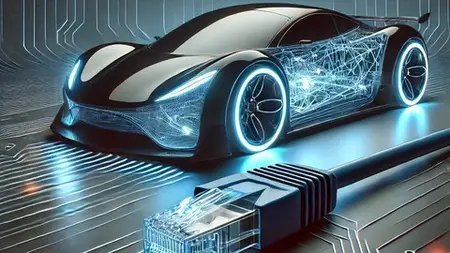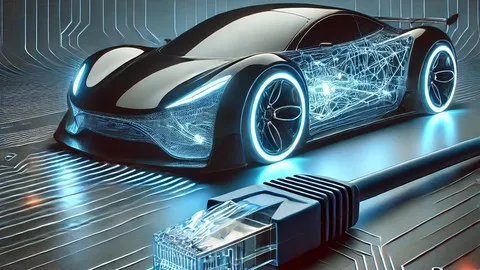Automotive Ethernet: Networking For Modern Vehicles
Published 9/2024
MP4 | Video: h264, 1920x1080 | Audio: AAC, 44.1 KHz
Language: English | Size: 2.34 GB | Duration: 4h 53m
Published 9/2024
MP4 | Video: h264, 1920x1080 | Audio: AAC, 44.1 KHz
Language: English | Size: 2.34 GB | Duration: 4h 53m
Ethernet, Autosar, BroadR-Reach, OSI, TCP I/P, SOME I/P, SoAd, EthIf, DoIP
What you'll learn
Introduction to Automotive Ethernet: Understand the basics of Ethernet technology and its significance in the automotive domain.
Ethernet Protocols: Dive into the key protocols such as AVB/TSN (Audio Video Bridging/Time-Sensitive Networking), which ensure real-time data transmission.
Network Design and Topologies: Explore various network architectures and topologies used in automotive Ethernet systems.
Ethernet PHY and MAC Layers: Learn about the physical and data link layers, including transceivers and controllers.
Implementations: Get in depth experience and techniques for configuring and troubleshooting Ethernet networks in automotive applications.
Automotive Specifics: Get in depth knowledge on the dynamics of Automotive Ethernet with automotive specific topics such as BroadR-Reach, Autosar SOMEI/P
Ethernet in Autosar: Get experience on how AUTOSAR Ethernet stack enables seamless communication by integrating the Ethernet Driver (ETH),
Ethernet Interface (EthIf), and Socket Adaptor (SoAd) layers to handle data transmission, routing, and protocol abstraction.
Requirements
No Pre Requisite, No Programming Skills required
Description
Welcome to the Automotive Ethernet Course!In the dynamic world of automotive technology, seamless communication within vehicles is paramount. As the backbone of modern in-car networks, Automotive Ethernet is revolutionizing how data is transmitted, paving the way for innovations like autonomous driving, advanced infotainment systems, and sophisticated driver assistance features.In this course, you'll embark on an in-depth journey through the realm of Automotive Ethernet, gaining essential knowledge and practical skills to harness this powerful technology. Whether you're an experienced engineer looking to expand your expertise or a newcomer eager to dive into the automotive industry, this course is designed to equip you with the tools and understanding needed to excel in the fast-evolving landscape of vehicle networking.Why Automotive Ethernet?As vehicles continue to evolve into more connected and autonomous systems, the complexity of communication within these vehicles has grown exponentially. Traditional in-vehicle communication protocols such as CAN (Controller Area Network) and LIN (Local Interconnect Network), which have been reliable for decades, are increasingly becoming insufficient. These legacy protocols were designed to handle low-bandwidth, low-speed applications like sensor data transmission and basic control signals. However, modern automotive systems generate massive amounts of data due to the integration of advanced driver assistance systems (ADAS), infotainment, over-the-air (OTA) updates, and vehicle-to-everything (V2X) communication.With features such as 360-degree camera views, LIDAR, radar, vehicle-to-cloud communication, and real-time diagnostics, the data flow within the vehicle has dramatically increased. Traditional communication networks like CAN and LIN struggle to meet the requirements of these high-performance applications due to their inherent limitations in bandwidth and latency. The need for a more robust, high-speed communication network has led to the widespread adoption of Ethernet in automotive applications.Why Ethernet?High Bandwidth: Ethernet provides far greater bandwidth than CAN, LIN, or even FlexRay. This allows for the simultaneous transmission of large amounts of data, making it perfect for applications like ADAS, real-time video streaming from cameras, and high-resolution displays in infotainment systems.Low Latency: Automotive applications, especially safety-critical systems, require low-latency communication to ensure real-time responsiveness. Ethernet meets these demands by offering fast data transfer speeds and prioritization mechanisms, allowing data to flow with minimal delays.Scalability: Ethernet is highly scalable, allowing for the addition of more nodes and devices without significant network redesign. This flexibility makes it ideal for future-proofing vehicles as new technologies and systems emerge.Flexibility: Ethernet supports a wide range of protocols and standards, making it versatile enough to handle everything from real-time critical systems to non-critical systems like entertainment. Its compatibility with existing IP protocols also enables easier integration with external networks such as the internet or cloud services.Cost Efficiency: Ethernet’s mass adoption in industries beyond automotive has led to mature, cost-effective technology. It offers an efficient solution for OEMs looking to upgrade their vehicle communication networks without significantly increasing manufacturing costs.Reliability and Robustness: The automotive Ethernet standard, particularly with the development of BroadR-Reach, enables Ethernet to be used even in harsh automotive environments. BroadR-Reach allows full-duplex data transmission over a single unshielded twisted pair (UTP) cable, reducing weight and cost while ensuring robust performance.Future-Oriented Technology: As the automotive industry moves toward full autonomy and vehicles become part of the larger Internet of Things (IoT) ecosystem, Ethernet is positioned as the go-to communication backbone. It enables vehicle-to-vehicle (V2V), vehicle-to-infrastructure (V2I), and vehicle-to-cloud (V2C) communication, which are vital for smart city integration and autonomous driving.Why Understanding Automotive Ethernet is Crucial?For engineers, developers, and automotive professionals, mastering Automotive Ethernet is essential for the following reasons:Autonomous Driving: Autonomous vehicles rely on a complex web of high-speed data transfers between sensors, cameras, radar, and LIDAR systems. Ethernet provides the backbone for this communication.In-Vehicle Networking: With Ethernet, in-vehicle networking becomes faster and more reliable, supporting seamless communication between ECUs (Electronic Control Units), infotainment systems, and safety-critical components.Over-the-Air (OTA) Updates: Ethernet allows fast, secure, and reliable OTA updates for vehicle software, helping OEMs keep their vehicles up to date without needing a service visit.Advanced Infotainment: Ethernet enables high-quality multimedia streaming, high-resolution displays, and rich infotainment experiences with minimal latency, making it a must for modern connected vehicles.Integration with External Networks: Automotive Ethernet, based on IP standards, ensures compatibility with external systems, enabling V2X communications and integration with cloud platforms for diagnostics, data analytics, and more.In conclusion, as vehicles become more connected, autonomous, and data-driven, Automotive Ethernet is not just a luxury but a necessity for handling the complex, high-bandwidth communication needs of next-generation vehicles. Understanding and implementing Automotive Ethernet is a vital skill for engineers, developers, and anyone involved in the design, manufacturing, and maintenance of modern vehicles. This knowledge will be essential in keeping up with the rapid advancements in the automotive industry and ensuring the efficient operation of future vehicles.
Overview
Section 1: Introduction
Lecture 1 Introduction To The Course
Section 2: Basics of Networking
Lecture 2 What is a network?
Lecture 3 Transmission Modes
Lecture 4 Casting in Networks
Lecture 5 Network Topologies
Lecture 6 ISO OSI Model
Lecture 7 Layers of OSI Model
Lecture 8 TCP IP Model
Section 3: Ethernet and Network Fundamentals
Lecture 9 Evolution of Ethernet
Lecture 10 Repeaters and Hubs
Lecture 11 Nomenclature And Physical Layer Anatomy
Lecture 12 NIC MAC & LAN
Lecture 13 Bridges And Switch
Lecture 14 Router and IP
Lecture 15 Address Resolution Protocol
Lecture 16 SubNets
Lecture 17 VLAN
Lecture 18 Dynamic Host Control Protocol
Lecture 19 Domain Name System
Lecture 20 Private and Public IP Address, NAT
Lecture 21 Network Socket & Transport Layer
Lecture 22 TCP Vs UDP
Lecture 23 Ingress And Egress Ports
Lecture 24 Ether Type
Lecture 25 IP Datagram Encapsulation
Section 4: Adaptation to Automotive Industry
Lecture 26 Exploring BroadR-Reach
Lecture 27 Ethernet Frame Format
Lecture 28 Ethernet Flow Control
Section 5: Autosar and Ethernet Stack
Lecture 29 Introduction to Autosar
Lecture 30 Ethernet and TCP/IPStack
Lecture 31 Socket Adaptor
Lecture 32 Ethernet Interface(EthIf)
Section 6: SOME/IP Protocol
Lecture 33 Introduction to SOME/IP Protocol
Lecture 34 More About SOME/IP Protocol
Lecture 35 SOME/IP Header
Lecture 36 Revisiting The Example
Lecture 37 SOME/IP Transformer
Lecture 38 Service Discovery
Section 7: Diagnostic Over IP (DoIP)
Lecture 39 Introduction to DoIP
Lecture 40 DoIP In Autosar Stack
Lecture 41 DoIP Network View
Lecture 42 DoIP Header Structure
Lecture 43 DoIP Sequence Diagram
Lecture 44 DoIP Configuration
Automotive Engineers: Enhance your expertise in modern vehicle communication networks.,Network Engineers: Transition your skills to the automotive industry.,Software Developers: Learn about the integration of Ethernet in automotive applications.,Students and Enthusiasts: Gain a foundational understanding of Automotive Ethernet.,Enroll now and drive your career forward with the knowledge of Automotive Ethernet!



